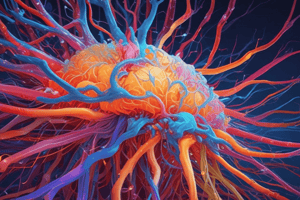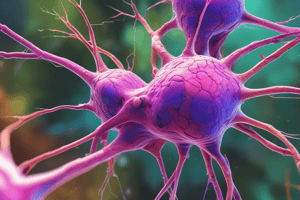Podcast
Questions and Answers
What is the role of the P pathway in visual processing?
What is the role of the P pathway in visual processing?
- It is responsible for color and form representation. (correct)
- It carries motion and spatial information.
- It processes depth perception illusions.
- It integrates feedback from the retina.
Which area of the brain is primarily associated with the integration of motion and spatial information in the visual system?
Which area of the brain is primarily associated with the integration of motion and spatial information in the visual system?
- Inferior temporal cortex
- V2
- V1
- Parietal lobe (correct)
How are the visual field maps, also known as retinotopic maps, organized in the cortex?
How are the visual field maps, also known as retinotopic maps, organized in the cortex?
- They follow the organization of the retina. (correct)
- They represent the entire visual input without spatial organization.
- They are mapped based on cortical layer structures.
- They are uniformly distributed across the cortex.
Which visual areas contain representations of full hemifields of visual space?
Which visual areas contain representations of full hemifields of visual space?
What unique feature distinguishes different visual areas in the visual cortex?
What unique feature distinguishes different visual areas in the visual cortex?
What is the main function of the inferior temporal cortex in visual processing?
What is the main function of the inferior temporal cortex in visual processing?
What shared characteristic do V1, V2, and V3 have in terms of visual information representation?
What shared characteristic do V1, V2, and V3 have in terms of visual information representation?
What pathway carries information relevant to motion and spatial aspects of vision?
What pathway carries information relevant to motion and spatial aspects of vision?
Which layer of the primary visual cortex is the main target of thalamocortical afferents?
Which layer of the primary visual cortex is the main target of thalamocortical afferents?
What type of neurons primarily populate the internal pyramidal layer V of the primary visual cortex?
What type of neurons primarily populate the internal pyramidal layer V of the primary visual cortex?
Which layer contains interconnecting axons and is primarily responsible for corticocortical efferents?
Which layer contains interconnecting axons and is primarily responsible for corticocortical efferents?
What does the molecular layer I of the primary visual cortex primarily consist of?
What does the molecular layer I of the primary visual cortex primarily consist of?
Which layer is responsible for maintaining precise reciprocal interconnections between the cortex and the thalamus?
Which layer is responsible for maintaining precise reciprocal interconnections between the cortex and the thalamus?
Which types of neurons are primarily found in the external granular layer II?
Which types of neurons are primarily found in the external granular layer II?
What structure causes the blindspot in the visual field?
What structure causes the blindspot in the visual field?
Which layer of the primary visual cortex is characterized by few large pyramidal neurons and many spindle-like neurons?
Which layer of the primary visual cortex is characterized by few large pyramidal neurons and many spindle-like neurons?
What represents the upper visual field in the visual cortex?
What represents the upper visual field in the visual cortex?
How does cortical magnification affect central vision compared to peripheral vision?
How does cortical magnification affect central vision compared to peripheral vision?
What is NOT a characteristic of cortical magnification in the visual system?
What is NOT a characteristic of cortical magnification in the visual system?
What anatomical feature reflects the organization of visual processing streams in the visual cortex?
What anatomical feature reflects the organization of visual processing streams in the visual cortex?
What type of cells are primarily involved in processing central vision?
What type of cells are primarily involved in processing central vision?
Which of the following best describes how cortical magnification manifests in the somatosensory system?
Which of the following best describes how cortical magnification manifests in the somatosensory system?
Which statement about the foveal representation in the visual field map is correct?
Which statement about the foveal representation in the visual field map is correct?
What role does the parvocellular pathway play in the visual processing?
What role does the parvocellular pathway play in the visual processing?
Flashcards are hidden until you start studying
Study Notes
Visual Field Representation in the Brain
- The dorsal part of the posterior occipital lobe represents the lower visual field, while the ventral surface represents the upper visual field.
- Visual cortex is organized into two streams: dorsal (spatial aspects) and ventral (color and form).
Cortical Magnification
- A phenomenon where certain areas of the sensory or motor cortex are disproportionately represented, leading to enhanced acuity in those regions.
- In vision, central (foveal) representation has a high number of neurons, enhancing sensitivity compared to peripheral vision, which engages fewer neurons.
- Cortical magnification occurs through various stages, starting with densely packed cones in the fovea and continuing through connected neural pathways to the visual cortex.
Primary Visual Cortex (V1) Layers
- Layer I: Contains scattered neurons, mainly extensions from dendrites and axons, minimal activity.
- Layer II: Composed of small pyramidal and numerous stellate neurons.
- Layer III: Predominantly small and medium pyramidal neurons, primary source of corticocortical outputs.
- Layer IV: Main target of thalamocortical afferents, consists of various neuron types (stellate and pyramidal).
- Layer V: Contains large pyramidal neurons (such as Betz cells), mainly for sending motor signals to subcortical structures.
- Layer VI: Mainly transmits information to the thalamus, containing large pyramidal and smaller spindle-like neurons.
Ocular Anatomy and Blindspot
- The optic nerve, formed from retinal ganglion cell axons, exits the eye at a location devoid of photoreceptors, creating a blind spot.
Visual Information Pathways
- Visual information flows from the retina to the lateral geniculate nucleus (LGN) of the thalamus, then to area V1 in the posterior occipital lobe.
- Visual pathways include the P pathway, associated with color and form processing (via blobs and interblobs in V1) and the M pathway, which conveys motion and spatial information to areas in the parietal lobe.
Retinotopic Maps
- Visual areas in the occipital cortex are organized based on retinotopic maps, highlighting proximity of cortical neuron activity with corresponding retinal image areas.
- Areas V1, V2, and V3 encompass representation of full visual hemifields, where each hemisphere corresponds to the contralateral visual field.
Research and Exploration
- Research continues to delve into the functions and structures of visual areas within the occipital, parietal, and temporal lobes, enhancing the understanding of visual processing in the brain.
Studying That Suits You
Use AI to generate personalized quizzes and flashcards to suit your learning preferences.




